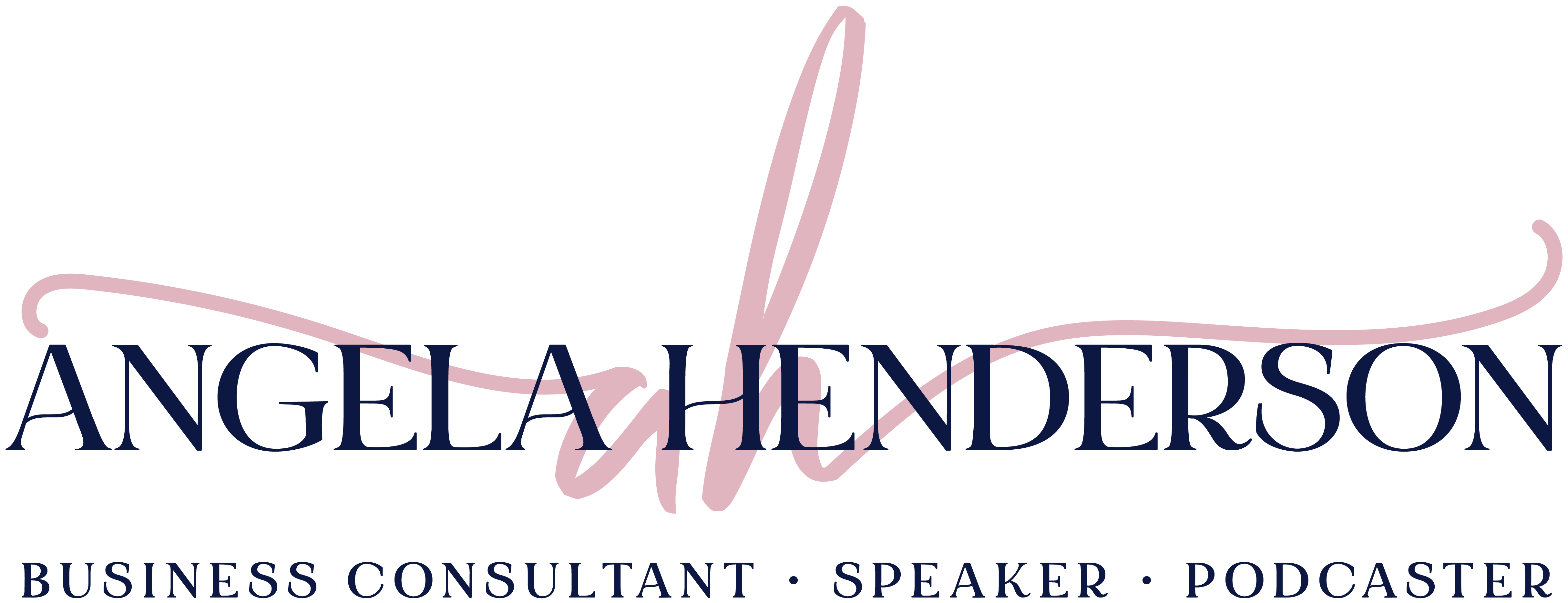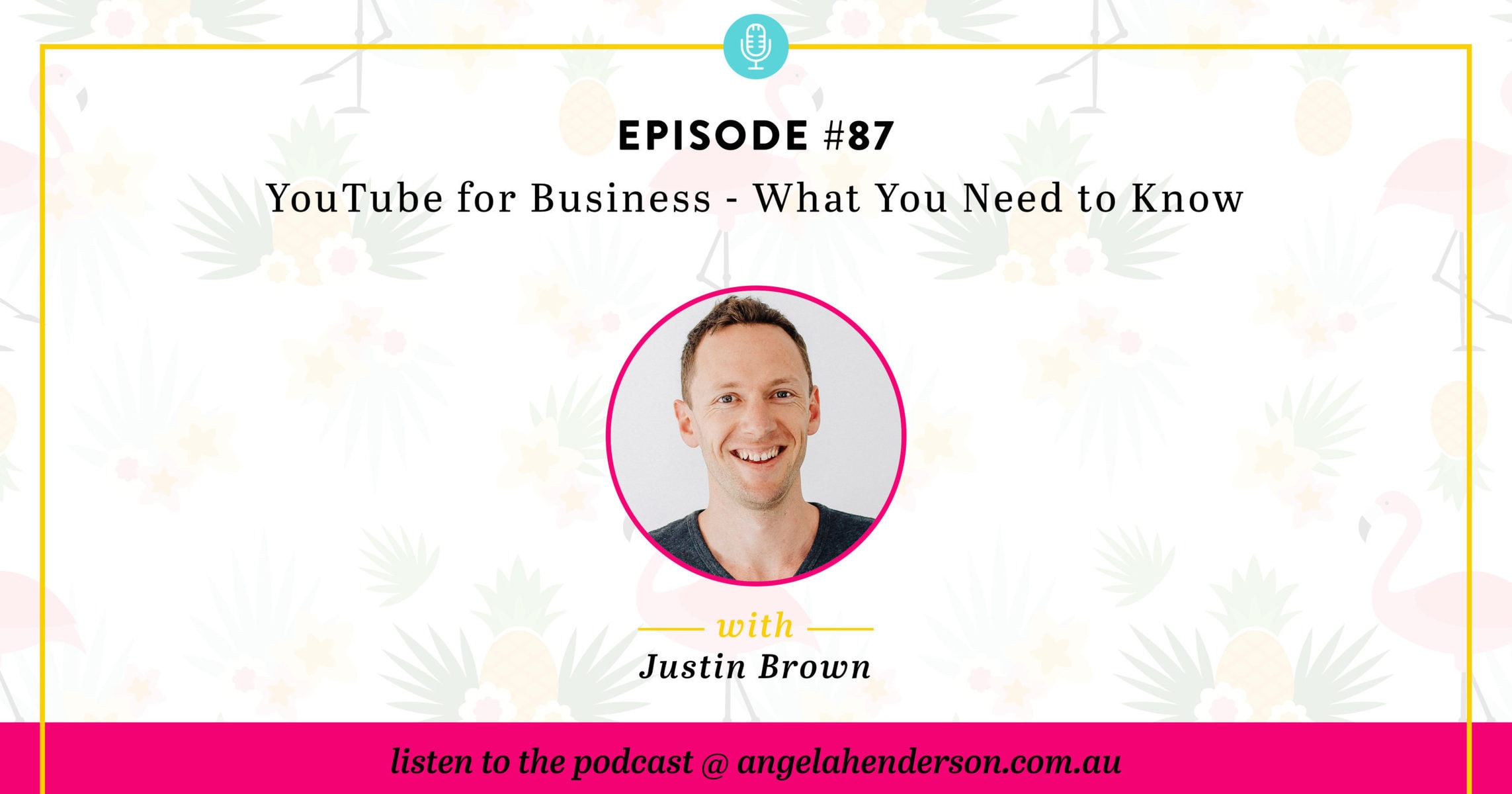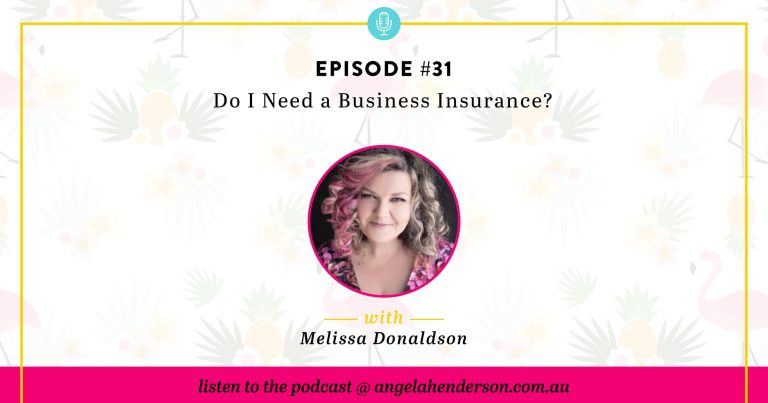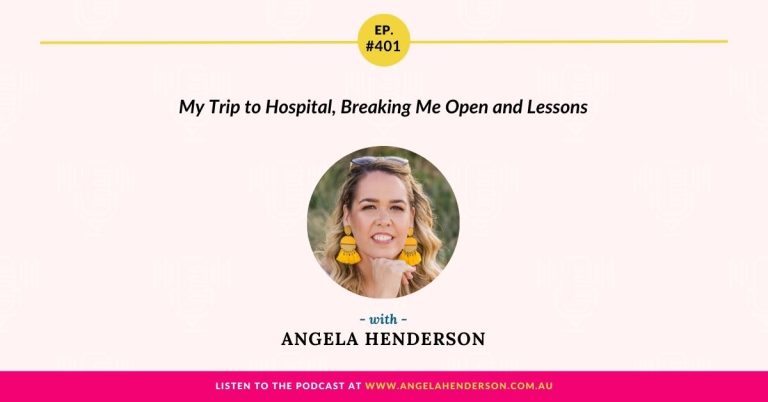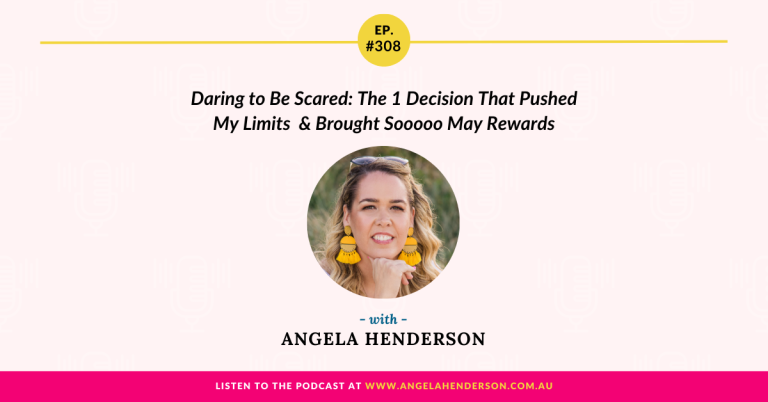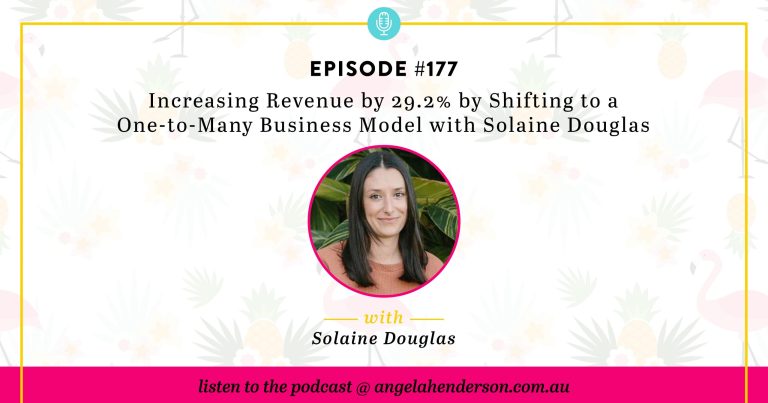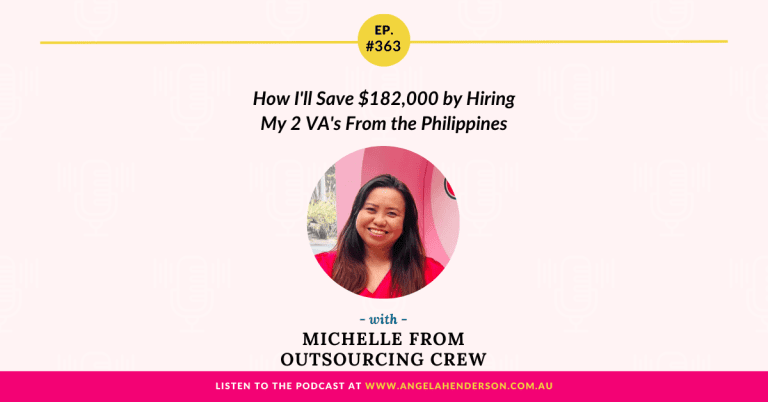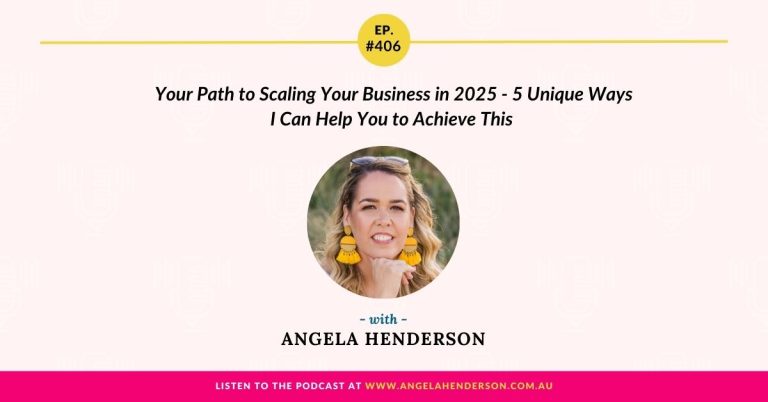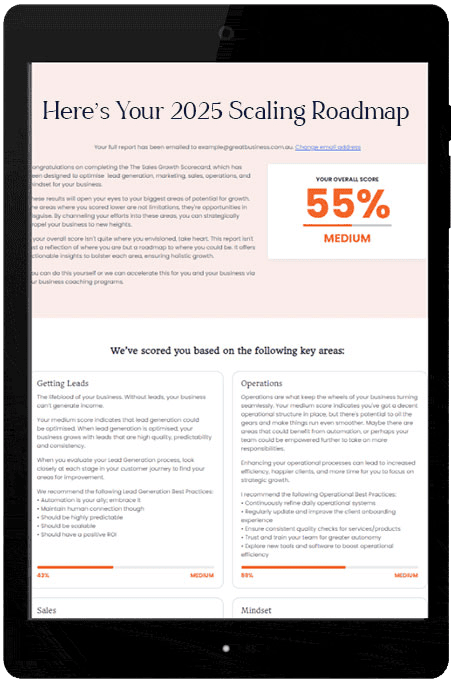YouTube has helped so many businesses thrive! Let’s be honest, we’ve all had our fair share of watching videos on this platform – myself included. But using it for business growth isn’t for the faint-hearted and a great strategy on this is key. So today, Justin Brown of Primal Video joins us to talk about the benefits of YouTube for business owners. Find out if your business is fit for starting a YouTube channel and dig in on hot tips from the YouTube expert himself on what to do to get your channel up and running in 2020.
Important Links Mentioned in the Show:
Action Takers with Angela Henderson
Angela Henderson Consulting Instagram
Women in Business Retreat 2020
Angela Henderson Active Business Facebook Group
Angela Henderson Facebook Business Page
Prefer to read YouTube for Business – What You Need to Know? Here’s the transcript:
ANGELA:
You’re listening to the Business and Life Conversations Podcast with Angela Henderson, Episode 87.
Hey there, you’re listening to the Business and Life Conversations Podcast. My name is Angela Henderson and on this show, we talk about improving your business, life or both, by having amazing and rich conversations with brilliant guests who will inspire you and who will give you tips and tricks to help you grow both in life and in business.
Well, hey there and welcome back to another awesome episode of the Business and Life Conversations Podcast. I am your host, Ange, from Angela Henderson Consulting where I’m a Business Consultant and Coach who has helped hundreds of amazing women business owners get all the pieces in place to have consistent five-figure months and then on to six-figure years without burning out in the process.
YouTube – YouTube is our hot topic today. And let’s be honest, YouTube is helping businesses around the world to kick some serious, serious ass. I mean, serious ass. You see, YouTube is for people of all ages. And let’s just say, Finlee, my 10-year-old, Chloe, my delightful little 6-year-old, and if I’m honest, me, too, have watched our fair share of unwrapping Kinder Surprise Eggs to see what toy is in the middle.
In fact, I probably have spent hours watching this with the kids over on YouTube. I know some of you are probably shaking your head or having a little bit of a laugh because you can relate. Those Kinder Surprise unwrapping on YouTube gets me every single time.
But YouTube is far more than just watching the unwrapping of chocolate eggs and toys in the middle, especially when it comes to businesses who want to use YouTube for growth. But as many of you probably know, YouTube is not for the faint-hearted. You do need some strategy just like you do with any other platform.
And that’s why I’m really excited to bring on YouTube Expert, Justin Brown, from Primal Video to share this with you. In this episode, we’re going to look at what are the benefits of YouTube for business owners? We’re also going to have a quick chat about who in business should start a YouTube channel because maybe it’s not right for everyone.
We’re also going to have Justin share with us his hot tips for starting a YouTube channel and we’re also going to explore should people create their own YouTube channel by themselves, should they join a course, do they outsource? What should they really do if they want to get this YouTube channel up and running and kicking some serious ass for 2020? And of course, as always, I’m a little bit of a chatterbox and we’re going to talk about so, so much more.
Now, before we hop straight into this amazing episode, I’d like to remind you that if you enjoy this episode, I would love, love, love for you to share your key takeaway, a fun fact or anything you’d love to share about the podcast over on your Instagram stories. And remember to tag me @angelahendersonconsulting because as you know, this would make my day.
And also, this episode is sponsored by my 12-month group coaching program, Profit Pillars, which helps women in business create consistent five-figure months. My 12-month group coaching program is for women business owners who are ready to take action to grow a sustainable and profitable business.
The program includes a complete Profit Pillars training system, complete with videos, PDFs and guides; monthly live coaching sessions, monthly hot seat calls, monthly mastermind classes with guest experts, 24-hours access to our private Facebook community, world-class member support, and so, so much more.
To learn about how you can join my 12-month group coaching program, you can head to angelahenderson.com.au and click on the button that says, ‘I Want Help Creating 5K Plus Months.’
Now, sit back and get ready for the YouTube episode of the year. Welcome to the show, Justin.
JUSTIN:
Thank you very much for having me on.
ANGELA:
Gosh. It is a pleasure to have you on, and like I said before we pressed record, we were in a great in-depth conversation about how the world is really so small and how the universe kind of brings people together because we only met; we’ve only seen each other, really, one time. It was for about 10-15 minutes in this random bar at Social Media Marketing World last year. I met you and your brother there. You guys were speakers at Social Media Marketing World.
And we had a quick chat there, we’ve stayed friends ever since. But this is really; I reckon we’ve talked more in the last 20 minutes than we probably have our entire life. But we are in each other’s atmospheres with people we know, how we work, etc. So it is pretty amazing.
JUSTIN:
It’s crazy that we only meet on the other side of the world, and yes, we could just keep talking for hours.
ANGELA:
That’s what I’m saying to you. I was like, “Oh my goodness. We’ve already been talking for 20 minutes. I’ve got another podcast episode right away. We have to press record now.” So yes. So thank you so much. YouTube. It is a hot topic, my friend, and everyone wants to be a YouTuber these days. Well, at least my children do. But let’s be honest, it’s not for the light-hearted. It is; strategy is key. As I’m sure, we’re going to learn from you today.
But before we hop on to all things YouTube, I’d like to ask you a question because I like the audience to get to know you a little bit more about who you are, Justin. So my first question is I saw that you were travelling over to the US just recently. You were running around on electronic scooters over in San Diego and I believed you stopped for a refreshing refreshment at some stage. So I’d love to know what is your all-time favourite beer. And I also know, I think you’re gluten-free, but you’re going to educate us about this.
JUSTIN:
Wow, you’ve really done your research. This is awesome.
ANGELA:
I have.
JUSTIN:
Okay. So, yes. A few years ago, I found out that I need to be gluten-free. Unfortunately, it’s not by choice. But anyway, I feel fantastic from dealing that way. But yes, I used to love craft beers and I would go and try as many different types as I can, and San Diego actually has quite a lot to choose from. So I can’t remember the name. I can’t give you a great answer here because whatever they’ve got, I’ll take it, I’ll try it because there’s still a lot of places that don’t, especially in Australia, it’s pretty hard to get a gluten-free beer on tap bar or pub bar or anything like that. So I love going to the States because they have so many more to choose from. So that is my drink of choice.
ANGELA:
That is your drink of choice. Yes. And I’ll have to put you on to my dear friend, I don’t know if you’d know James Rose. He is a legend. He was on the podcast just recently, too. But I’ll put you together because he’s like the craft Australian beer king, and if Jimmy knows anything, he will be able to hook you up with some gluten-free beer. So, yes.
JUSTIN:
Sounds awesome. Thank you. I appreciate it.
ANGELA:
Anyways, I’m glad today’s topic; we will get to YouTube. We’re just getting the beer out of us first.
JUSTIN:
The important stuff, yeah.
ANGELA:
So then, can you tell our audience a little bit about you, Justin? Like, what’s your background? We all know that you’re a rockstar when it comes to YouTube, but have you always been into YouTube? Can you tell us a little bit more about where you’ve come from?
JUSTIN:
Cool. So my background is in video production. I’ve had some amazing opportunities to work with some really influential people. I’ve got documentaries on Netflix globally; worked with extreme sports athletes and big wave surfers and some crazy stuff I had to do to get the shot and to work with those people. Feels like another life I go now, but it really wasn’t that long ago.
So what I like now about helping people grow their business and brand with YouTube is that my chances of dying at work are a lot less than it used to be with skydiving and free diving and breath-holding and all that sort of stuff. So that’s a bit about my background, but where we kind of pivoted from the doing the video stuff to now teaching and helping people see a return on it was we were noticing more and more that the videos that are converting for people aren’t necessarily the polished ones where they go and get a production company out to film everything.
Obviously, there’s still a place for those videos and they keep your story video for your business or for your brand; that should be shot well, I think. But for the intro; all the small pieces of content – relationship-building content; that’s the stuff that the more real and the more raw it is, and like if you’re just shooting it with your phone, that kind of stuff is the stuff that converts because it’s real.
So what we were finding is a lot of my clients outside of booking me for the biggest shoot, they weren’t creating videos themselves. So they weren’t really seeing a big return on having a video strategy. So that’s where we’re like, “Okay, we need to understand this huge thing and help people with this because there’s no point making a video at any scale unless people see it.”
ANGELA:
Exactly right. Because again, it’s not here, as we said, for shits and giggles. People want a conversion for most time. Unless you are like unwrapping those like chocolate eggs that I talked about earlier on in the intro is where it’s like kids’ YouTuber. But for business, it’s like, there needs to be; you’re putting an investment into your business, but you eventually need to see the ROI.
JUSTIN:
Yeah. And for us, starting out, we weren’t seeing the ROI and we were doing what everyone else does and just throws the videos up on this YouTube thing. And I think we were six months in or maybe seven months in and we had about 50 subscribers and some of those were friends and family.
ANGELA:
Right.
JUSTIN:
What are we doing wrong here? I’m a video person and we can’t make this work? So we had no strategy and that was really frustrating. We literally nearly cancelled and said like, “This is a bad ROI for our business. The amount of time and effort that we’re putting into this and we are seeing no results.” Yeah, and we see that all the time. That’s really what sort of encouraged us to keep going with this because everyone is just starting at that same place.
Know they need to do a video, know that YouTube is a good place for it, but then you start to see that it’s not working for you and you’re like, “Oh, well. Maybe I missed the ball. YouTube is too overcrowded. There’s already other people doing what I want to do. Or maybe it’s me.” And then they start to go down a spiral and whatever else from there.
ANGELA:
The self-doubt, the confidence and everything else; exactly right. Where it’s like, I’m again, done is better than perfect. I’m just like, get in there; you can always capitalize later sometimes. But you still need some level of strategy.
Now, YouTube; when we were at Social Media Marketing World this year, Mike had talked about the kind of three main strategies that he was talking about, and YouTube was one of them, Instagram was another. And so, there’s a lot of interest in people going like, “I’ve got to jump on the bandwagon of YouTube, etc.” But before we get into that, can you tell us a little bit about YouTube; where it was, where it is now, how many people are using it?
JUSTIN:
Yeah. So it is ridiculous. Like, it’s a 14-year old platform and a lot of people are saying, “Oh, it’s kind of had its time. It’s done.” Well, it wasn’t that long ago. I think it was the start of the year, they said that they had 1.8 or 1.9 billion monthly active users. That’s a B for the billion. But then, they’ve updated that later; I think it was November this year, so fairly recently. And yeah, it’s over 2 billion monthly active users now.
ANGELA:
Wow.
JUSTIN:
I mean, at 14 years, it’s still growing pretty strong and out of those 2 billion monthly active users, 1 billion hours of content is viewed every day and that’s growing as well. So lots of opportunity.
ANGELA:
So much opportunity. And I mean, let’s be honest, there’s a slight addiction in our first-world country. I mean, countries all around, but first-world in particular. People are addicted to their phones, their Ipads, their computers. So there is a high chance that one of us or all of us have been on YouTube today doing something; whatever that is.
And so, there’s an equally good chance that those people, your ideal client are equally out there doing the exact same thing, trying to get help on YouTube to solve some of their business problems. And I guess that leads me to my next question is what are the benefits of YouTube for business owners?
JUSTIN:
Okay. I would say that there’s a couple of big ones. I think the biggest one that a lot of people aren’t really aware of or are more so starting to get aware of now is that YouTube, it’s owned by Google, but you can get your videos ranked not only on YouTube but also in Google search. So the benefit of that or the beauty of that is your potential viewers, your potential customers, subscribers, your ideal market, they may not be searching for a video. They go to Google. They might be looking for a blog or anything, or just for the answer for a pain or a problem that they have and a video shows up.
And people are much more likely to click a video to save them reading or anything like that to get the answer that they want. So that is one of the biggest powerful things with YouTube and that’s how we generate so much traffic as well is that we optimize our videos for YouTube and for Google search because you got to remember that YouTube is primarily a search engine. As much as a place to throw your contents up, it’s a search engine. So you’ve got to help people find your content or help YouTube feature your content in front of the right people.
ANGELA:
Fantastic. And would you also say that because, with video, people are hearing you, seeing you; from that, one of the other benefits is that you’re building your credibility, your trust and authority a lot quicker than just say a standalone blog article where they’re reading it, but they’re not hearing you and seeing you. What are your thoughts about that?
JUSTIN:
Yeah. 100%. I mean, if all you can do is write a blog, that’s awesome. If you’ve got the time to start with a video; I mean, if you start with video, you can always like get it transcribed and work backwards to a blog or repurpose to other platforms as well. So I definitely think that the more we can connect as humans, we see our voice, we instinctively want to know who that person looks like.
So that’s where with podcasts, it’s so important to have your face on your branding, on your podcast episodes and those sorts of things where people can tie that to you. Like, whether we are actively thinking about it or not, we want to know as humans who that face is.
ANGELA:
Exactly.
JUSTIN:
I mean, it’s not to say that you have to be in the video; there’s a lot of people that their fear of being on camera is pretty strong and even starting out. Mine was, too. I’m a behind-the-camera person, not a in-front-of-camera person. So it’s all about pushing comfort zones but think of the impact that your content can have and push past that fear of being on camera and look at the impact and the ripple effects from you helping people with your content.
ANGELA:
And I just actually spoke about that over on my Facebook group, the Australian Business Collaborative, the other day; yesterday, actually, about the fear of rejection. And a lot of people, too, similar to that fear of YouTube, “What are they going to say? They’re not going to like me.” Again, that fear of rejection.
And I’m just like, at the end of the day, people are, all of us, collectively, we are judging every second of every minute of every single day. So whether or not you’re on YouTube, whether or not you’re running a blog, whether or not you put a post up, whether or not you walk down the street, people are judging you.
People are judging me and you right now because of my Canadian accent and your Australian accent. People will like your tips about YouTube, people won’t. People will like how quickly I talk; they won’t. So we’re getting judged everywhere. And so, yes, so again, I could talk a whole another episode about judgment and the fear of judgment and those beliefs and stories we need to let go of. But yes, start somewhere, right?
And as we’ve said, done is better than perfect. Now, for businesses who are out there going, “So I heard YouTube is great. I obviously can get found in Google also. There’s a lot of benefits here.” But should all businesses hop on YouTube and start a channel or are there certain businesses you find do better? Or yeah, what are your thoughts about that?
JUSTIN:
So the quick answer to this question is I’ve never found a business or a niche or an industry that wouldn’t benefit from having people, their ideal customers find them 24/7, having them search for something and you be the one that shows up with a video, ideally. And that’s what the power of YouTube is. I mean, it’s the same, you want to go into with the strategies, it’s not just about creating amounts of content or uploading daily videos that there are a lot of these experts out there are saying, right?
ANGELA:
Yes.
JUSTIN:
It’s about being strategic with the content that you’re putting out. So to answer your question, I would take a step back. And it’s not about necessarily promoting your immediate products or services, but where are your ideal clients or subscribers or that the long term people that you end up working with, where are they at right now long before they know about you or maybe have any interest to purchase or to join your thing? So what are they doing and where are they stuck? How can you help them at the most 101 level? And you create that content and show up for them there.
So it doesn’t need to be specifically about your business and brand, but obviously, the topics that are related to that, that people would be searching for. So it sounds so counterintuitive to go really 101 with that, but you’re able to help and impact so many people, and you inherently become the expert or the go-to person that helped people with that and they wanted then to take that next step with you.
It’s alright for us, our content is 101 level on YouTube, but we’ll always offer the next step for those action takers, the people that want faster results and without the headaches and those sorts of things; those are the people who you want in your courses and programs and working with you one-on-one; not the tire kickers. So it’s the perfect place for that.
ANGELA:
Yup. And what, for those people that always say, “Yeah, but I’m just giving away my free stuff.” Like, they kind of get like, “Womp, womp.” I kind of look at them like Debbie Downers. But, “Oh, I’m giving them so much amazing knowledge.” But what I found over my time in being in business is that if you give away really great content that is solving their pain points, they’re naturally; you leave them with a good feeling versus like a yicky-yuck feeling of, “Oh, that was a waste of my time.” And they’re eager to learn more about you or stick around to watch the next YouTube episode or whatever that is. Do you agree with that or what are your thoughts about that?
JUSTIN:
I agree with that. If I could say 1,000%; I know there’s not a thing. But everything comes from leading with value first. For us, we don’t hold back on our content on YouTube. And that’s what we teach; put your best stuff out there. But what you can then sell and what you can offer is the in-person stuff; the done-for-you services. Or even you can look at; for us, we sell our processes and systems. So the exact stuff that we do.
Like the click here, click here, do this; that’s the stuff that we sell outside of the sort of the broader topic discussions on YouTube. You can watch those videos and you can go away and you can do it yourself. But if you want the exact road map, then that’s how we’ve kind of split the two. Because this is the question we get asked all the time, “If you’re putting out this much content for free, why would I pay you?” So it’s a different level of interaction, it’s a different level of service, and a different way that people can accelerate their results really.
ANGELA:
Exactly. And I like that word, accelerate, right? Is like, you can continue to keep trying to piece everything together yourself, or again, we’ve got everything for you, right? So I also look at like your time and energy is how many hours do you want to try and figure this out and potentially, you’re going to do it wrong versus going, “Hey, here’s the road map.”
But I also think like, when you lead with value, there’s so much goodness that comes from that and that if you do lead with value, so many times people say, “Well, I just know that when I listen to your podcast or when you’re in your Facebook group, Ange, I knew that if you showed up this much already for free, what the hell? Like, how good is it going to be if I’m actually paying you?”
Like, you know, “I want you in my corner.” And I can only imagine people are the same with your YouTube stuff with you and your brother is that they are like, “Holy shit, this is so good.” And that community, too, it’s not just about the program people are buying. People buy from you if you do good content or YouTube or blog, etc. because they want community.
JUSTIN:
100%. And a lot of people disregard the YouTube community as not really being a thing. All the people that you would probably see as being competitors to us and our competition, we’re good friends with all of them. We have messages going back and forth. Like, it’s not about the competition, it’s we’re all helping people and we’re all growing our own businesses and brands and it really is an amazing community.
But I think you touched on something there, too, with like the amount of content. People are like, “I would much rather buy your 5-minute video that tells me exactly how to do that than to go and sit and spend hours on YouTube trying to find the answer to something.” So there’s always people that will want that fast track that are happy to, yes, save their time. Like just, “You tell me what to do.”
ANGELA:
Yup. And so, I guess what we’re trying to say is that give away your free content because when you give away good and you lead with value first, you’re going to end up with an ROI. And one of my sayings that again, I’m very big at saying is conversations equal conversions. And so, YouTube is a wonderful way for you, even though you’re not having like a two-way conversation, you’re still opening up the words for conversations to happen. And so, just think about how those conversations will turn into conversions through your YouTube channel.
Now, people out there, obviously, there’s a million things that there’s probably running through their minds, “Okay, this is great. What should I do?” What are your top tips for anyone, like listen, I don’t have a YouTube channel? And one of the things is I don’t, but it’s on the list as to-do for 2020 is when I was at Social Media Marketing World last year; when you go to these big conferences, there’s so many amazing ideas thrown at you and it can become quite overwhelming if you’re new to that kind of space.
And what I always say is I’m always about, “Choose one, do it well.” Put the systems in place; put the processes in place, etc. So for me is I was refining my podcasting and stuff last year, so there wasn’t space for YouTube to come on board. But would you agree that like for those that are out there and they genuinely want to hop into YouTube, like pick one; don’t try and do YouTube, Pinterest.
I mean, if you got copious amounts of money and teams that can do that, that’s cool. But would you say to them like choose YouTube, do it well, Justin, and then move on to something else? Like, what are your thoughts about that?
JUSTIN:
100%. Do one. I mean, we have a Facebook page. I couldn’t tell you what’s on it. My Instagram is just me playing around. But YouTube, for us, is our business focus; that’s where we’re generating all of our organic traffic, our leads, and growing our email list. That is what’s driving our business and we focus on one thing. Now, we now have the ability, we have some stuff and we’re going to start looking at some of these other platforms, but we’re four or five years down the track with this after going deep with one platform.
And that’s where I love YouTube as well because all of the changes, all the algorithm changes and everything; like, I’m sure you hear a lot of stuff in the media – Adpocalypse and YouTube is dying, and it’s blocking kids content and all this stuff; like it’s on the way out. All of this is actually helping with YouTube’s goal, which is just put the right videos in front of the right people at the right time. So it’s about the human experience on the platform.
So if you’re creating content, going back around to my number one tip, you want to make sure you’re going into it with a strategy and not just creating the videos that you think might help people. YouTube helps you with the data; the data for those Americans.
ANGELA:
Yeah.
JUSTIN:
I always get some crap about that. But they give you the information that you need to know what people are searching for. So the biggest mistake that we found, which was that point where we nearly gave up was I was creating tips that I thought would change people’s lives, and they probably would have if they ever found the videos; those might have helped people.
But people aren’t searching for the tip or for the hack. They’re typing in the pain or the problem that they have and that’s a big distinction between the content that you’re not just talking about the answer. They’re never going to search and find the answer specifically, but they’ll search for the problem and then you’ll address the problem in your video and your content.
So it really is about taking that approach and looking at what are your ideal people who would be watching your videos, where are they at businesswise? Where are they at in regards to the topics that you’re covering? Are they an absolute beginner? Do you need to do a 101 video or are you happy to target more advanced people?
In which case, the terminology and everything that you’re using in your videos is going to be aimed more so towards those people. So you really want to have that kind of goal and strategy in place, and then, if you’re looking for topics, it’s alright to say, “You just go and find it and YouTube gives you the data.”
ANGELA:
Yup.
JUSTIN:
If you go to YouTube or to Google and start typing in stuff, we’ve all seen that auto-fill, that suggested box, “Did you mean this?”
ANGELA:
Yes.
JUSTIN:
Right? But all of those things that is giving you suggestions around are based on previous searches. So those things are things that people are actually searching for and have previously searched for, so that is the best place to go for topics.
Now, really quick pro trip; I don’t want to stick on this for too long, but if you use the underscore, the little line at the bottom, that is going to be like a wild card. So you could type in how to underscore and then something about your niche or your business and that’s going to say, YouTube fill in the blank or Google fill in the blank to see what people are searching for around how-to or best or DIY or any words really.
Just use that underscore between and it’s going to give you so many topic ideas for what people are actually searching for. And then, obviously, create those videos and speak to that; speak to those people where they’re at based on you knowing what they need to know if they’re searching for that.
ANGELA:
No. Great tip there because again, if you don’t know what they’re searching for and you start to assume that you’re going to be doing all this work in creating content that doesn’t actually need to be created because it’s not what they want.
JUSTIN:
It’s pretty frustrating making videos where no one sees them.
ANGELA:
And that’s why, yeah, it’s like again, then you get frustrated, “Oh, that didn’t work.” Well, no. It didn’t work because you didn’t do it. You did it for yourself, not for your ideal client. And I know like one of the things that we do in our Facebook community when people join, there’s three questions that you can have on Facebook. And one of our questions is, “What are you struggling with?” Our second question, “Do you have a business? What are you struggling with? And do you want to stay on our email list?”
And then, we automate that with Zapier into a spreadsheet and we’re able to collate all of their information and all their pain points that they’re struggling with and we then look at those; we look for the common threads where there’s the highest amount of pain points for the same type of topic and that’s where we’ll start looking at creating podcasts, blog posts, etc. or even when I do my live.
So that has been a great tool for us to be able to capture. And another way that again, you can go and do exactly what Justin said about Googling up, but if you do have a Facebook group or an email list, you can always create a survey also and just ask them. There’s a beautiful book called Ask and it talks about sometimes you just have to ask your clients what it is that they need or want or are struggling with, then you can get so much amazing information by surveying your audience.
JUSTIN:
Yeah. I agree 100%. And I don’t know why in businesses, we think that we can’t go and ask.
ANGELA:
Exactly.
JUSTIN:
It’s like, “No, we’re supposed to be the experts. We don’t need to know. I mean, we should know what these answers are.” Where really, another way to finding out then to ask.
ANGELA:
Exactly right. Just ask them. And I think that’s again when people are driven by ego is that they’re so driven by the ego element of it that they forget. So your top tips for starting a YouTube channel; one is obviously, understand, like you said, what your ideal client’s pain points are; two, then start looking for titles around that; and then three, is there anything else that you think that you’re like, “Okay, next, you need to start really thinking about XYZ.”
JUSTIN:
Okay. I’d love to tackle this one really quickly because this is when we see, once you understand all of that stuff, the next big procrastination point is around the gear, the tech, and what to say in your videos. And even if you’ve got all the keyword research and everything done, that’s the stuff that’s going to stop you in your track.
So what I want to say is that it doesn’t matter what camera you use, you can get great results with your webcam. You can use your smartphone; we’ve all got these amazing cameras in our phones these days. Just start and just practice. And your own voice critique is going to be you; you may not like the sound of your voice, how you look, how you come across. It doesn’t matter, put it out there because we all think that all of these procrastination points; fear of judgment, really, as we’ve touched on a few times here.
No one really cares about this stuff as much as you, but if you look at the impact you’re able to have with the content that you’re able to share and put out there, not only is it going to scale your business massively, but it’s also going to impact a lot of people.
One of the key moments for us, and I share this story quite often because it really was a real factor for us was when we’re about to shut down and stop creating videos, we got one comment that came through and it was, “Thank you so much for creating this video. You’ve helped me create my first video for raising awareness for autism or autistic kids.”
So at that moment, it’s not about me creating videos, talking to a camera in the backroom of my house. It’s now like, “Holy shit. This is actually impacting people.” Those tips actually helped someone and their cause is something that I would have never thought that this would help spread the word around that and get someone else’s message out.
So that’s where we kind of really have to get out of our own way this stuff and then worrying about how you look or sound on camera really becomes irrelevant at that point. But what I will say is done is better than perfect. Use what you have; upgrade when you’re hitting the limits of the gear that you’ve got or you’re able to. If you’ve got the dollars to get a camera, awesome, but that doesn’t mean your video is going to be better. So start with what you have and upgrade when you can or when you need to.
ANGELA:
I love it because I know even with like podcasting gear, everyone’s like, “What mic do I need?” And I’m like, I call bullshit. Just record, right? Like, just record because it’s actually not about the gear; that’s just the barrier to entry. I’m just like, “Just record.” And I’m like, right now, I’m on my little; like $249 mic that I’ve had for this entire time. My coach, James Schramko did give me one of his mics; I can’t. It’s like a Rode, whatever. I still have yet to implement it because I was just like, “Oh, I haven’t had time to get the stand.”
But like, you don’t need expensive gear at the beginning. Like you said, and I love that you said it because so many people get fixated on, “I just don’t have the gear. I don’t have the money to do that.” Where I’m like “If you look at it, it is.” But what you’re doing is you’re not getting your voice out there and you’re actually; it’s a detriment to those people that need to hear your voice and to learn from you.
JUSTIN:
Selfish.
ANGELA:
And yeah, so it’s just like, if you’ve got knowledge, which every one of us has as business owners and you’re going to make that impact, don’t worry about the gear. Just start talking and recording.
JUSTIN:
Yeah. There’s no one else out there with the same knowledge, same experience, same thoughts, opinions, personality as you. If you could think other people are out there making the videos that you want to be, shave your thoughts and opinions and all of those sorts of things on the same topics because they might resonate with you and not them or the other way. It really doesn’t matter. It’s all helping the global, collectively.
ANGELA:
Yeah. I couldn’t agree more. I know I was; I’ve talked about this on the podcast before. When I was speaking at We Are Podcast last year, Pat Flynn, myself, Steph Taylor and I, we were on a panel and it was about the impact that podcasts; like what impact has our podcast had on people? And Pat’s like; he goes first and he’s like, I mean, those of you that don’t know Pat Flynn, just Google the guy, right? But most people probably would know, but Pat is an amazing entrepreneur over in the United States. He’s had a lot of impact on people and he’s like; he builds schools and he does all this.
And at that stage, I’d only released, I think it was Episode 9; I could be wrong. And I was like, “Oh, I don’t really know about the impact I make.” And the next thing you know, Pat Flynn like calls me out and he goes, “No, no, no, no, no.” And I was like, “Oh, fuck.” Right? It’s Pat. This isn’t good. And then actually, what happened was because I had been suffering depression and anxiety at that particular stage, I was holding myself back. So Pat made me cry and later on Pat was like, “Oh my God. I’m so sorry.”
But it was like, people came up to us afterwards because they were like, “That was actually the best part of the conference we’ve ever seen because it wasn’t staged. Nothing was scripted. You guys just said it how it was.” And what we’ve talked about is I, even though I’ve been a blogger, one of Australia’s leading parenting bloggers and working with Netflix and some big companies, in my space of podcasting, I thought I had made an impact.
But when I looked at how I started speaking about mental health and we had saved one of these ladies from harming herself, etc. that’s like, that’s the thing is we minimize because we don’t think we’ve had big numbers and we don’t do this. And it’s like, remember, we all start at zero. And so I guess it’s the same thing with your YouTube channel is you’re going to start at zero subscribers, right? You’re going to have nothing. But you don’t have to have 10 people or 20 people or 30 people. Remember, it’s better to have a thousand raging fans than it is to have 200,000 people on your Instagram account. So just think about that impact.
And I know another thing is I remember when I reached 70 something thousand people over on my Facebook page for my first business and I was seeing all these other people that had like 100,000 and 200,000. And someone said, you know, there’s like this big stadium here in Brisbane; Suncorp Stadium and it fits 52,000 people. And they’re like, “You do realize that you fit an entire stadium of people and some?”
And that really was a pivotal moment because again, those numbers; like if you think about it, if you have 10 people that you were speaking to as subscribers. 10 people, you’re speaking to; how many people could you get into a room with you? And then 20 people? And then 30 people? It’s like crazy. So it’s like again, put that fear aside because every person that listens to you, you’re helping them to make a bigger impact. So it’s a ripple effect.
JUSTIN:
Yeah. It’s so crazy, like with the people looking at views and numbers, and as you said, like we forget that they are real people. Every view is a person.
ANGELA:
Yes.
JUSTIN:
If you got 10 views on your first video, that’s 10 people that have watched your video that you’ve impacted. So that’s really where it’s always; we’re comparing ourselves. “Yeah, but that guy did a video and he got 100,000 views.” You’ve got 10. 10 people and these 10 people could now be your biggest fans that are going to go on and tell 10 more people or whatever. Yeah.
ANGELA:
And that’s the thing is you build your ecosystem. Like there’s so many; like I’ve got about 6,000 over people in my Facebook community, and clearly, not all of them have bought from me. But there’s random people that will start tagging me in other groups or they’ll say, “Oh, someone in your Facebook group recommended you or whatever.”
JUSTIN:
Yeah.
ANGELA:
So now, I know, obviously, anyone, I would say with my next question I have is around should people do this on their own? Should they buy a course? Should they outsource? Obviously, you and I, we both have programs. Yes, of course, we want people to buy from us, but that’s still might not be the right avenue for people.
So what are your thoughts for people wanting to start a YouTube channel? Like, do you have like a test about, “Okay. Yes, you should outsource this or you should take a course.” Like, is there any guidance you can give people?
JUSTIN:
So it’s one of those interesting things where I think everyone kind of wants to give it a go themselves first and I kind of really do encourage that so that you can see what’s involved. But at the same time, if this is a strategic move for you with your business, then you should really be doing the things that only you can be doing.
So even for us, I’m a video editor, I love editing videos. But for the last three years, we’ve been outsourcing the editing and I can’t tell you how much of a fear that was for me to think that someone else would handle that and what would people think if I’m teaching this stuff and I’m not even doing my own.
ANGELA:
Right.
JUSTIN:
But what we really teach is how you use video for business. And so, that’s why I love talking about the business side of it is like you can hire an editor to come in and do your videos for you for as little as $3 to $7 US an hour. We have a few editors on our team and they are absolutely amazing.
So I would really look, yes, get an understanding of it. See how it works. Obviously, it’s still you and your message, so you’re the one who’s going to have to work to refine that, to really work out. Look at the people whose videos you already like; what do you like about them? Pull those apart.
Obviously, if you’ve got the ability to work with a production company or something like that, go for it. But I think that it’s not needed these days. Just really, pull out your phone and start talking when you’ve done that research and have that strategy in place, but focus on the 1% improvement every time.
Every new video; how could you bring the energy up a bit? How could you go deeper on a topic? Interact with your people on the comments. Again, they’re real people. Whatever they’re asking you, whatever they’re voicing; as long as it’s a good comment or a good question; these are real concerns, real people. And just even just acknowledge them is going to go a long way.
But obviously, yes, we have a course around this stuff and I guess the beauty in any course is that you’re learning from the people who have done like all the falling over, all the stuff that doesn’t work. We are constantly investing in courses for that reason. Like, how can I jump the learning curve?
So for us, when we were starting out, we got to the point where we were buying YouTube courses and those sorts of things. And exactly the same for us moving into LinkedIn and those sorts of things now, we’re now looking at courses and stuff on those. So it really comes down to how serious you are and how fast you want to start getting off on the right foot with things.
ANGELA:
And I’ve also found that again if this is your business; because we’re not talking about how to start a YouTube channel for Easter eggs.
JUSTIN:
Yes.
ANGELA:
We’re talking about YouTube channel for your business. And that again, there comes strategy behind that and when you invest, alright? It’s all about investing in the growth of your business. And so, for me is one of the things that I found is that transformation in business doesn’t typically happen ‘til a transaction occurs.
And so, if you want like; you can still be like slowly on that journey, right? But when you invest in something and you actually have a transaction, your mindset shifts. You take things a little bit more seriously, you take a little bit more action. So I’m all about people looking at getting the tools and resources they need from the right people and investing. It helps you not just with personal growth and business growth, but the mindset growth also.
JUSTIN:
I’ve been gifted from good friends, like logins to courses just to go through them. And I can tell you that I’d never really went through them until I invested and paid for the course. Even though I had access to the course, as you said, the transformation is the transaction. You committed then. You’re actually going to pay to make it happen. It’s not so much about what video or how many modules or whatever is that you’ve committed to see that through.
ANGELA:
Exactly right. Now listen, and you are my first YouTube person on the podcast because I’m very choosy because the thing is I need to make sure that the people that come on to the podcast are genuine people that actually know what they’re talking about and they’re not blowing smoke up people’s asses. So that’s why again, we’ve been trying to get you on just because of my schedule and then me going shit, and then now, we’re almost how much? Social Media Marketing World is going to come around the corner in no time.
So yes, I’m thrilled to have you onboard because I’ve seen what you do. You’re a speaker at Social Media Marketing World. You are known for this, this is your zone of genius. So where can people find you if they’re wanting to start that YouTube channel and learn from the best?
JUSTIN:
Thank you very much for all the kind words. I guess this is part of it where when you enjoy what you do and you can see the effects from what your business and what you teach; the flow on, it’s just so much more fun. So if you want to find out more, you can head to primalvideo.com or to our YouTube channel, which is youtube.com/primalvideo.
ANGELA:
Alright, fantastic. And I’ve got one final question for you. What do you know now that you wish you knew when you first started out in business?
JUSTIN:
I come back to one that I mentioned a few times is doing the research and seeing how you can best help people. It’s not what we think in a lot of cases. The conversations that we have with people in a lot of cases are a lot more beginner level to get them in, to build that know, like and trust with them. Get them where they’re at. And that’s where doing that keyword research or the market research even.
Like, it applies not just to YouTube and it applies to everything; to communication in business. Really understand who are the people that you want to attract and how you can help them as the first and foremost. I mean, I wish I was diving deeper on that stuff much early on.
ANGELA:
100%. I mean and that’s what again, that would be a whole another topic about SEO strategy and all that. But I know, I’ll quickly say before we wrap up, Pat Flynn surveyed his audience years ago and because he was creating all this content and it was a quite advanced content. And after he surveyed his audience, it was like the majority of his audience had never even made; like I think it was between a dollar and $500 in their business.
So the highest percentage of people who were reviewing Pat’s and engaging in this content was that cohort of people. So Pat had to pull his entire; rest of his content strategy and create a new strategy to meet the demands of those people who are actually learning and wanting to learn from him. So again, the importance of researching and understanding your audience.
JUSTIN:
Yeah. And I think a lot of people, we see this; I know we’re going to wrap up. But I see a lot of people do this when they go jump straight and they create an online course, they’ll create what they think people want. And I know that we; the first course we ever created, we were going down the path of doing the same thing.
Instead, we launched it as a beta and we built it out with our customers to build what they wanted. And the difference is you’ve then got something that you know people want instead of what you think they want, which is a hard sell because you kind of convince them that this is what they need.
ANGELA:
Exactly. “This is what you need.” Absolutely. Look, thank you so much today for being on. And before we sign off, please remember, my team and I will also be putting together the whole transcription for this episode at angelahenderson.com.au. And as I mentioned earlier, if you enjoy this episode, I would love for you to share it, especially over on the good old Instagram stories and tagging me @angelahendersonconsulting. Or as you know, you can share wherever; I’m cool with that because I would just love that anyways.
And if you haven’t already subscribed to the Business and Life Conversations Podcast or left a review, I would greatly appreciate that, too. Thanks so much being on the show again today, Justin. And for the rest of you, have a fabulous day no matter where you are in the world and I look forward to you joining me next week for another amazing episode of the Business and Life Conversations Podcast.
Thanks for listening to the Business and Life Conversations Podcast with Angela Henderson, YouTube for Business. www.angelahenderson.com.au
